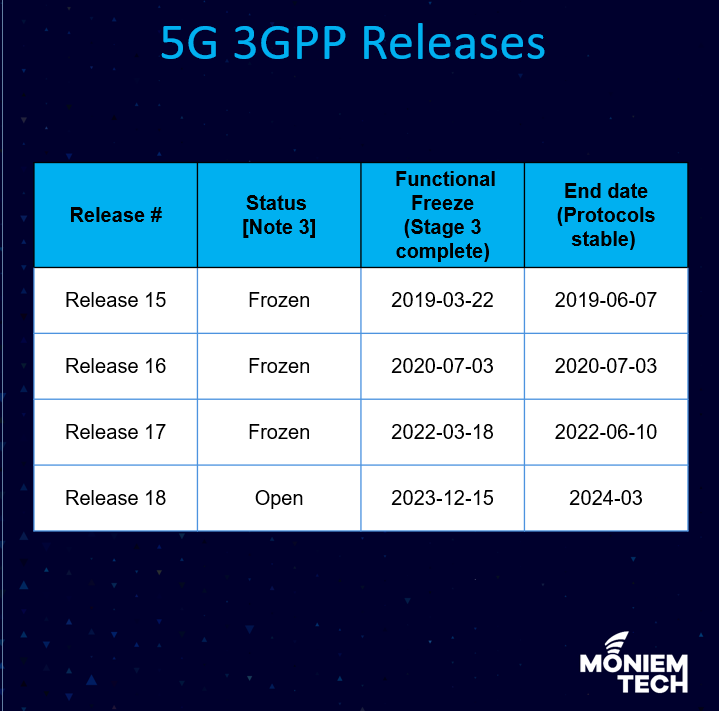5G is an evolving standard. The initial version of 5G was accomplished with the freezing of Release 15 late-drop in summer 2019. Enhanced features originally were introduced in Release 15 and new features were incorporated in Release 16 in 2020. More enhancements of features defined in prior releases and new features are part of Release 17 which was frozen in Mid-2022.
The initial specifications of 5G, Release 15, provided the fundamental architecture of 5G and addressed the use cases that include the famous “magic triangle” of enhanced Mobile Broadband (eMBB), ultra-reliable and low-latency communications (URLLC), and massive machine-type communications (MTC). Release 16 and Release 17 have focused on enhancing those use cases, especially URLLC and mMTC.
5G 3GPP Releases
3GPP uses a system of parallel “Releases” which provide developers with a stable platform for the implementation of features at a given point and then allow for the addition of new functionality in subsequent Releases.
The table below shows the most recent Releases only. The data is extracted from the 3GPP portal at https://portal.3gpp.org/, select the “Releases” tab, which shows all of the Release dates (since 1987).

Release 15
While initial specifications enabled non-standalone 5G (NSA) integrated into previous-generation LTE networks, the scope of Release 15 expands to cover ‘standalone’ 5G SA, with a new radio system complemented by a next-generation core network (5GC). It also embraces enhancements to LTE and, implicitly, the Evolved Packet Core (EPC). This crucial way-point enables vendors to progress rapidly with chip design and initial network implementation during 2019.
For more details: Release 15
Release 16
Release 16 was a major release and necessary to broaden the overall system specifications of Release 15. Release 16 brought extensions to V2X communications (i.e., 5G NR-based direct device-to-device communications or sidelink communications) to extend automated and remote driving, Industrial Internet of Things (IIoT), enhancements to URLLC, numerous energy efficiency changes, Integrated Access and Backhaul (IAB) (that brings a relay function to 5G), coexistence support for non-3GPP systems such as improvements in wireline and wireless systems, mission-critical public warning systems, improvement in voice, multimedia, and streaming services, NR-Unlicensed (NR-U), and 5G positioning or location-based services (LBS).
For more details: Release 16
Release 17
Release 17 features already in the pipeline include new work and/or enhancements for URLLC for NR-based IIoT, NR-based NTN, MIMO, integrated access and backhaul (IAB), MBS positioning, NR multicast, and broadcast services, RAN slicing for NR, NR sidelink, multi-RAT dual-connectivity (MR-DC), support for multi-SIM devices for LTE/NR, and NR small data transmissions in an inactive state and multimedia priority service.
For more details: Release 17
Release 18
Work items possible for that release may include enhancements of multimedia telephony services, vehicle-mounted relays, smart energy and infrastructure, and enhancements to support residential 5G. One of the more interesting items anticipated for Release 18 is a study on the performance requirements for AI/ML model and data distribution, distributed/federated learning, model transfer, and training requirements, operations splitting, and characterization of use cases such as image recognition, video improvements, robotic control, speech recognition, and automotive networks.

For more details: Release 18
